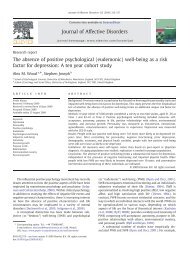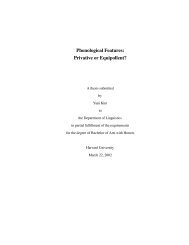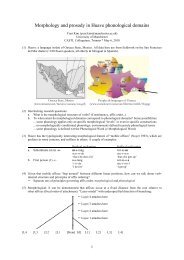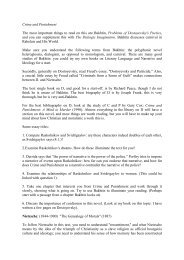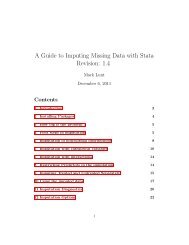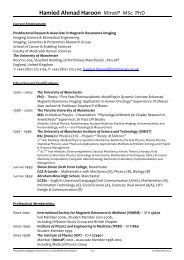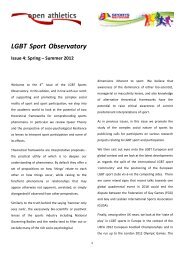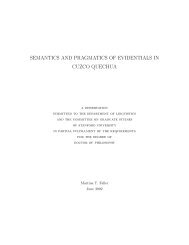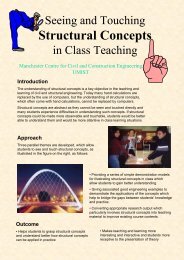Create successful ePaper yourself
Turn your PDF publications into a flip-book with our unique Google optimized e-Paper software.
Transitional Roughness ( 5 < < 70<br />
+<br />
k s )<br />
Both roughness and viscous effects operate.<br />
+<br />
(These k s limits are those of Schlichting. White gives 4 and 60 instead, whilst Cebeci and<br />
Bradshaw’s transition formula below uses <strong>2.</strong>25 and 90.)<br />
An all-encompassing mean-<strong>velocity</strong> profile may be written<br />
+ 1 +<br />
ln<br />
~ +<br />
+ ( ) k B y U<br />
where<br />
~<br />
B<br />
= s<br />
⎧B<br />
⎪<br />
⎨<br />
⎪⎩<br />
B<br />
( k<br />
→<br />
k<br />
1 +<br />
− ln k s<br />
+<br />
s<br />
+<br />
( k s<br />
Suitable interpolation formulae are:<br />
Cebeci and Bradshaw (1977):<br />
→<br />
~ 1 +<br />
B ( 1−<br />
) B + ( B − ln k ) ,<br />
= k<br />
s<br />
Apsley (2007):<br />
~ 1<br />
= B − ln( k<br />
+<br />
B k<br />
s<br />
+ C)<br />
,<br />
0;<br />
hydraulically<br />
smooth)<br />
→ ∞;<br />
fully rough)<br />
⎧ 0 ,<br />
⎪<br />
+<br />
⎪ ⎡ ln( k ⎤<br />
s / <strong>2.</strong><br />
25)<br />
= ⎨ sin⎢<br />
⎥ ,<br />
⎪ ⎣ 2 ln( 90 / <strong>2.</strong><br />
25)<br />
⎦<br />
⎪⎩<br />
1 ,<br />
C = e<br />
( Bk −B<br />
)<br />
> 90<br />
< 90<br />
Turbulent Boundary Layers 2 - 6 David Apsley<br />
k<br />
+<br />
s<br />
+<br />
s<br />
<<br />
<strong>2.</strong><br />
25<br />
k<br />
<strong>2.</strong><br />
25<br />
(Both authors used slightly different values of B and Bk from those used in these Notes).<br />
In practice, we are often more interested in the resulting friction law (see Section 3). For pipe<br />
flow this is the Colebrook-White formula. The effect of surface roughness depends on its<br />
form as well as its size. The work of Colebrook (1939) and Moody (1944) helped to define<br />
“equivalent sand roughness” for many commercial pipe materials.<br />
Geophysical Flows<br />
Perhaps the ultimate in rough-wall boundary layers is the atmospheric boundary layer. In this<br />
case the mean <strong>velocity</strong> profile is typically written (with the meteorological convention of z<br />
for a vertical coordinate):<br />
u z<br />
U = ln( )<br />
(16)<br />
z0<br />
z0 is called the roughness length and comparison with the above formulae, fitting all<br />
constants inside the natural logarithm and taking Bk = 8.5, gives z0 ≈ k s / 30 . For typical rural<br />
conditions z0 has a value of about 0.1 m.<br />
¡<br />
< k<br />
+<br />
s







